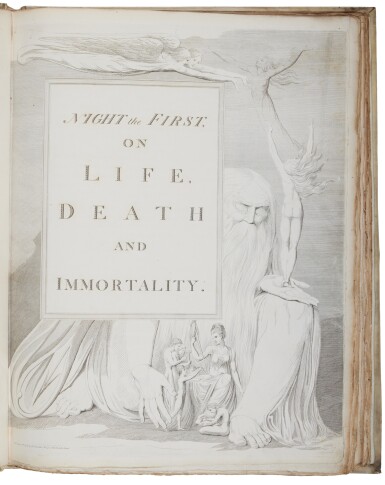
Property of a Blake Collector and Scholar
Blake, William | Illustrations for Edward Young's Night Thoughts, from the library of Lady Harriet Hesketh, a subscriber
Lot closes
June 26, 06:30 PM GMT
Estimate
7,000 - 10,000 USD
Starting Bid
6,000 USD
We may charge or debit your saved payment method subject to the terms set out in our Conditions of Business for Buyers.
Read more.Lot Details
Description
Blake, William
Edward Young. The Complaint, and the Consolation; or, Night Thoughts. London: R. Noble for R. Edwards, 1797
Folio (428 x 318 mm, uncut). 43 engraved pictorial border illustrations by and after William Blake; some illustrations shaved (as usual), without the "explanation of engravings" leaf (as often), scattered marginal soiling. Contemporary vellum over boards, spine gilt; front cover bowed, lightly soiled.
A significant association copy of Night Thoughts, whose illustrations by Blake were termed by Sir Geoffrey Keynes as "splendid examples of plain line engraving done by an artist whose creative energy sought to burst through the limitations of his craft."
Lady Harriet Hesketh became acquainted with Blake through her friendship with Blake's patron William Hayley. Lady Hesketh was also a niece of the poet William Cowper, and Blake supplied illustrations for a biography of Cowper by Hayley. Lady Hesketh gave Blake permission to make an engraving after her portrait of Cowper by Lawrence. Hayley corresponded frequently with Lady Hesketh about Blake, and he defended the artist vigorously when her opinion of his social standing (or lack thereof) affected her appreciation of his work.
"This was the largest commercial project for which Blake was ever employed. With what must have been enormous energy, he executed 537 water colors illustrating the poem's nine sections, which Young called "Nights." Edwards began the project by having the pages from the first and second editions of the poem glued into windows cut into large leaves of Whatman wove paper. These text pages were positioned slightly off-center so as to create a lower margin greater than the upper and an outer margin greater than the inner, as in most letterpress books. Blake filled these large marginal spaces with his designs—a format retained in the published engravings with the letterpress text of the poem printed in a central framed panel" (The William Blake Archive).
Forty-three of Blake's designs were engraved for what was intended to be a first installment of the Night Thoughts, but no further parts were issued. "Perhaps baffled by the novelty of Blake's interpretations, the public was not receptive, and the book remains a remarkable fragment" (Ray). Blake's disappointment in the failure of Night Thoughts probably contributed to his decision to leave London in 1800 for Felpham on the Sussex coast, where he met a new patron, William Hayley, who made him known to the owner of this copy.
REFERENCES:
Bentley, Blake Books 515; Bentley, "Blake, Hayley, and Lady Hesketh," inThe Review of English Studies, VII, 27 (1956): 264–286; Bentley, Blake Records, passim; Ray, The Illustrator and the Book in England 3
PROVENANCE:
Lady Harriet Hesketh — The Fermor-Hesketh Library at Easton Neston (armorial bookplate of Sir Thomas Hesketh, Bart., & Easton Neston press-label 33/G; Sotheby's London, 15 December 1999, lot 60)
You May Also Like


![[Austen, Jane] | "Selfishness must always be forgiven, you know, because there is no hope of a cure.”](https://dam.sothebys.com/dam/image/lot/8f2a8203-a25f-45fb-a170-01cb685711c1/primary/extra_small)





![(Hamilton, Alexander, James Madison, and John Jay) | Praised by George Washington as a "work [that] will merit the notice of Posterity"](https://dam.sothebys.com/dam/image/lot/459e7d5b-79ee-401d-9876-5480601bce8b/primary/extra_small)
![[Austen, Jane] | "It is a truth universally acknowledged..."](https://dam.sothebys.com/dam/image/lot/7425dc27-4c5b-4ae4-aee6-567636a1d526/primary/extra_small)
